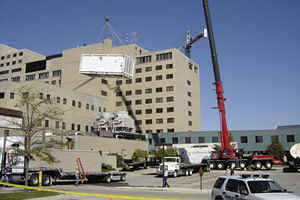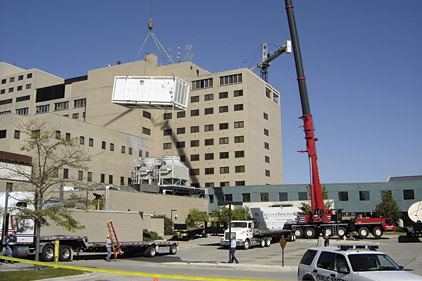
|
| Portable units can be used as a permanent solution when the situation calls for it. Some companies use portable units for redundancy if their main system has a problem, or if the room isn’t at the right temperature. |
Even though portable HVAC equipment is often selected as a temporary answer, the units are commonly being cemented as permanent solutions.
Mike Paulson, president, AmeriCool Inc., said during the late 1990s, when large computer rooms became more evident, a lot of people began retaining their portable units.
“You had a lot of people realizing these units, when kept as permanent solutions, could save a lot of money,” Paulson said.
“A lot of companies take our unit, put it in their server room, and put it on standby, thus it’s in there permanently,” he said. “If the room ever drops below a certain temperature, or another unit goes down, our unit will automatically engage and cool the room.”
Server rooms aren’t the only places where portable cooling units are seen as a permanent solution. Hospitals are another place where making sure people and things stay cool is of the utmost importance.
“A lot of hospitals have their own fleets of units,” Paulson said. “Some of the bigger hospitals can have 15-20 units of their own. The other thing with portables that is nice is some of these bigger server rooms that get different hotspots, the portability factor of being able to move the units to fix that is very helpful.”
In some applications, portable units offer an increase in energy efficiency by cooling a specific area instead of firing up a big unit that cools areas where cooling isn’t needed.
“Portable air conditioners are popular because of their flexibility, but that flexibility encompasses more than just the ability to move a unit from room to room,” said LeeAnne Perkins, national advertising manager, Heat Controller Inc. “There’s a wide variety of settings in which a portable can be used, both for residential and commercial applications.”
“You just roll it in, plug it in, and turn it on,” said Eddie Stevenson, marketing manager, MovinCool. “If you’re in an office space, you just have to duct hot air out. Some of these units just run off the standard plug. It’s quick, easy, and can be rolled from one room to the next. That’s the beauty of these products.
“We’re not striving to force people to use them permanently. These units are there and available as needed. We just want to make sure people know a portable air conditioning solution exists, because a lot of people still don’t.”
The ability to rent or own a portable unit is extremely helpful to consumers, especially those who inhabit an older building where ductwork or electrical issues are prominent.
Also, for businesses strapped when it comes to capital expenditures, being able to pick up and relocate the equipment is often very useful.
“It depends on what type of application, but for pretty much any type of application, if the business is in a leased facility, the benefit is they can take it with them when they go,” said Tina Behnke, customer experience officer, AirPac Inc. “If you install a system, it’s great for the building owner because you leave it in the building when you leave. It’s a sunk cost for the person who has to buy it.”
The most important thing, though, is these units don’t hamper office efficiency by being too noisy, disrupting work along the way.
“The key on these units is that they are designed to be very quiet, so they can fit right into an office environment and not bother people,” Paulson said.
“In terms of cost, it’s a fraction of the cost of buying a permanent unit. To me, that’s huge. The units are designed to run 24/7 and they’re built for the environment. It can be a permanent solution.”
Dane Taival, vice president of building services, Trane North America, said users utilize portable units permanently when they need flexibility in the way they finance systems or stage production.
“Portable units are attractive because they offer flexibility, can be expensed versus capitalized, and provide portability from one site to the next,” he said. “This is ideal for situations when future activity is unpredictable and cyclical needs are either process-driven or ambient-driven.”
Even though using a portable unit as a permanent solution for an application isn’t going to be the answer every time, it is an attractive option.
“The equipment has gained acceptance over the years,” said Clark Michel, vice president, Atlas Sales and Rentals Inc. “There’s not the skepticism that existed 20 years ago. Contractors like it and they know there’s a use for it. It’s not going to be the solution every time, but in some cases, it makes for a very easy fix.”
Publication date: 7/1/2013
Want more HVAC industry news and information? Join The NEWS on Facebook, Twitter, and LinkedIn today!



Report Abusive Comment